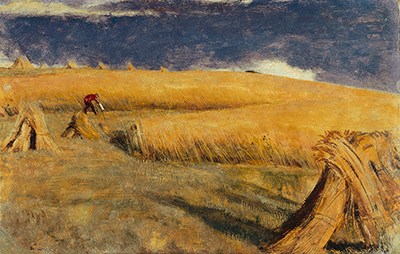This piece is one of the most prominent examples of the doctrines espoused by many of the contemporary painters associated with the Pre-Raphaelite time period. Known particularly for its accurate representation of natural surroundings, William Holman Hunt was said to have created this image while staying on his uncle's farm during the summer of 1849.
It is also thought that the work itself was painted on the spot and this is partially confirmed thanks to a small annotation on the back of the canvas. Hunt has primarily focused upon the organic nature of the farm itself; lending only a minor importance to a worker collecting bales of nearby wheat.
A Snapshot of Nature
One of the core tenets emphasised by the Pre-Raphaelites was the ability to replicate discrete aspects of nature that was often not associated with Mannerist artists such as Allesandro Allori and El Greco. This approach is clearly seen in Cornfield at Ewell. His depiction of the natural environment is not stylised in any way. On the contrary, it captures a realistic image of what might otherwise be called an everyday farming task during the middle of the 19th century. Hunt has nonetheless achieved a sense of aesthetic balance thanks to his subdued use of colour.
A Pale Hint of Things to Come
It should be noted that Cornfield at Ewell was one of the first well-known works produced by Hunt. This would soon be followed by other pieces such as Valentine Rescuing Sylvia from Proteus (1851) and The Light of the World (1854). In contrast to later works, Cornfield at Ewell places a heavy focus upon nature and its relationship with man; the surrounding almost dwarfing the worker in the background. It is also interesting to observe that his use of colour is much more subdued when compared to his later paintings.
Having said this, Hunt has still been able to achieve a tonal balance thanks to what some have termed a "cropped" image. The equal presence of a tan landscape and a sapphire blue sky also provide a silent sense of harmony. It is almost as if Hunt was attempting to seize a particular moment in an unabashed fashion; presenting nature in all of its raw beauty with few embellishments. However, this painting was nonetheless not nearly as popular at the time when compared to his religious works that would soon follow.




